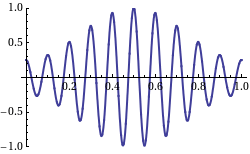Phase velocity



The phase velocity of a wave is the speed of any surface of constant phase. This is the velocity at which the phase of any one frequency component of the wave travels. For such a component, any given phase of the wave (for example, the crest) will appear to travel at the phase velocity. The phase velocity of light waves is not a physically meaningful quantity and is not related to information transfer.[2]: 18
Sinusoidal or plane waves
[edit]For a simple sinusoidal wave the phase velocity is given in terms of the wavelength λ (lambda) and time period T as
Equivalently, in terms of the wave's angular frequency ω, which specifies angular change per unit of time, and wavenumber (or angular wave number) k, which represent the angular change per unit of space,[2]
Beats
[edit]The previous definition of phase velocity has been demonstrated for an isolated wave. However, such a definition can be extended to a beat of waves, or to a signal composed of multiple waves. For this it is necessary to mathematically write the beat or signal as a low frequency envelope multiplying a carrier. Thus the phase velocity of the carrier determines the phase velocity of the wave set.[3]
Dispersion
[edit]In the context of electromagnetics and optics, the frequency is some function ω(k) of the wave number, so in general, the phase velocity and the group velocity depend on specific medium and frequency. The ratio between the speed of light c and the phase velocity vp is known as the refractive index, n = c / vp = ck / ω.
In this way, we can obtain another form for group velocity for electromagnetics. Writing n = n(ω), a quick way to derive this form is to observe
We can then rearrange the above to obtain
From this formula, we see that the group velocity is equal to the phase velocity only when the refractive index is independent of frequency . When this occurs, the medium is called non-dispersive, as opposed to dispersive, where various properties of the medium depend on the frequency ω. The relation is known as the dispersion relation of the medium.
See also
[edit]References
[edit]Footnotes
[edit]- ^ Nemirovsky, Jonathan; Rechtsman, Mikael C; Segev, Mordechai (9 April 2012). "Negative radiation pressure and negative effective refractive index via dielectric birefringence". Optics Express. 20 (8): 8907–8914. Bibcode:2012OExpr..20.8907N. doi:10.1364/OE.20.008907. PMID 22513601.
- ^ a b Born, Max; Wolf, Emil (1993). Principles of optics: electromagnetic theory of propagation, interference and diffraction of light (6 ed.). Oxford: Pergamon Press. ISBN 978-0-08-026481-3.
- ^ "Phase Velocity: Waves and Signals". electroagenda.com.
Bibliography
[edit]- Crawford jr., Frank S. (1968). Waves (Berkeley Physics Course, Vol. 3), McGraw-Hill, ISBN 978-0070048607 Free online version
- Brillouin, Léon (1960), Wave Propagation And Group Velocity, New York and London: Academic Press Inc., ISBN 978-0-12-134968-4
{{citation}}: ISBN / Date incompatibility (help) - Main, Iain G. (1988), Vibrations and Waves in Physics (2nd ed.), New York: Cambridge University Press, pp. 214–216, ISBN 978-0-521-27846-1
- Tipler, Paul A.; Llewellyn, Ralph A. (2003), Modern Physics (4th ed.), New York: W. H. Freeman and Company, pp. 222–223, ISBN 978-0-7167-4345-3






